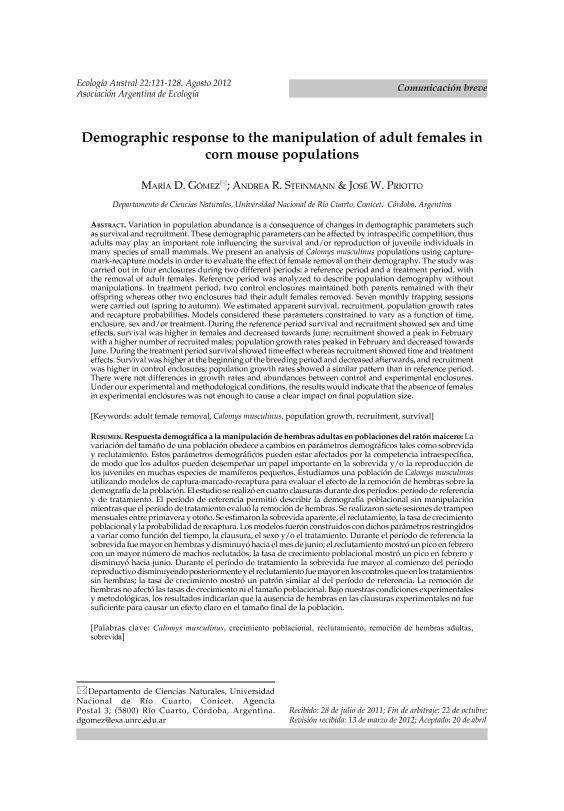Mostrar el registro sencillo del ítem
dc.contributor.author
Gomez, Maria Daniel
dc.contributor.author
Steinmann, Andrea Rosa

dc.contributor.author
Priotto, Jose Waldemar

dc.date.available
2023-05-18T13:53:41Z
dc.date.issued
2012-08
dc.identifier.citation
Gomez, Maria Daniel; Steinmann, Andrea Rosa; Priotto, Jose Waldemar; Demographic responses to the manipulation of adult females in corn mouse populations; Asociación Argentina de Ecología; Ecología Austral; 22; 2; 8-2012; 121-128
dc.identifier.issn
0327-5477
dc.identifier.uri
http://hdl.handle.net/11336/198012
dc.description.abstract
Variation in population abundance is a consequence of changes in demographic parameters such as survival and recruitment. These demographic parameters can be affected by intraspecifi c competition, thus adults may play an important role influencing the survival and/or reproduction of juvenile individuals in many species of small mammals. We present an analysis of Calomys musculinus populations using capturemark- recapture models in order to evaluate the effect of female removal on their demography. The study was carried out in four enclosures during two different periods: a reference period and a treatment period, with the removal of adult females. Reference period was analyzed to describe population demography without manipulations. In treatment period, two control enclosures maintained both parents remained with their offspring whereas other two enclosures had their adult females removed. Seven monthly trapping sessions were carried out (spring to autumn). We estimated apparent survival, recruitment, population growth rates and recapture probabilities. Models considered these parameters constrained to vary as a function of time, enclosure, sex and/or treatment. During the reference period survival and recruitment showed sex and time effects, survival was higher in females and decreased towards June; recruitment showed a peak in February with a higher number of recruited males; population growth rates peaked in February and decreased towards June. During the treatment period survival showed time effect whereas recruitment showed time and treatment effects. Survival was higher at the beginning of the breeding period and decreased afterwards, and recruitment was higher in control enclosures; population growth rates showed a similar pattern than in reference period. There were not differences in growth rates and abundances between control and experimental enclosures. Under our experimental and methodological conditions, the results would indicate that the absence of females in experimental enclosures was not enough to cause a clear impact on final population size.
dc.format
application/pdf
dc.language.iso
eng
dc.publisher
Asociación Argentina de Ecología

dc.rights
info:eu-repo/semantics/openAccess
dc.rights.uri
https://creativecommons.org/licenses/by-nc-sa/2.5/ar/
dc.subject
Adult female removal
dc.subject
Calomys musculinus
dc.subject
Population growth
dc.subject
Recruitment
dc.subject
Survival
dc.subject.classification
Ecología

dc.subject.classification
Ciencias Biológicas

dc.subject.classification
CIENCIAS NATURALES Y EXACTAS

dc.title
Demographic responses to the manipulation of adult females in corn mouse populations
dc.type
info:eu-repo/semantics/article
dc.type
info:ar-repo/semantics/artículo
dc.type
info:eu-repo/semantics/publishedVersion
dc.date.updated
2023-05-09T14:39:12Z
dc.journal.volume
22
dc.journal.number
2
dc.journal.pagination
121-128
dc.journal.pais
Argentina

dc.journal.ciudad
Buenos Aires
dc.description.fil
Fil: Gomez, Maria Daniel. Universidad Nacional de Río Cuarto. Facultad de Ciencias Exactas Fisicoquímicas y Naturales. Instituto de Ciencias de la Tierra, Biodiversidad y Ambiente - Consejo Nacional de Investigaciones Científicas y Técnicas. Centro Científico Tecnológico Conicet - Córdoba. Instituto de Ciencias de la Tierra, Biodiversidad y Ambiente; Argentina
dc.description.fil
Fil: Steinmann, Andrea Rosa. Universidad Nacional de Río Cuarto. Facultad de Ciencias Exactas Fisicoquímicas y Naturales. Instituto de Ciencias de la Tierra, Biodiversidad y Ambiente - Consejo Nacional de Investigaciones Científicas y Técnicas. Centro Científico Tecnológico Conicet - Córdoba. Instituto de Ciencias de la Tierra, Biodiversidad y Ambiente; Argentina. Universidad Nacional de Río Cuarto; Argentina
dc.description.fil
Fil: Priotto, Jose Waldemar. Universidad Nacional de Río Cuarto; Argentina. Universidad Nacional de Río Cuarto. Facultad de Ciencias Exactas Fisicoquímicas y Naturales. Instituto de Ciencias de la Tierra, Biodiversidad y Ambiente - Consejo Nacional de Investigaciones Científicas y Técnicas. Centro Científico Tecnológico Conicet - Córdoba. Instituto de Ciencias de la Tierra, Biodiversidad y Ambiente; Argentina
dc.journal.title
Ecología Austral

dc.relation.alternativeid
info:eu-repo/semantics/altIdentifier/url/http://www.scielo.org.ar/scielo.php?pid=S1667-782X2012000200005&script=sci_abstract&tlng=pt
Archivos asociados
